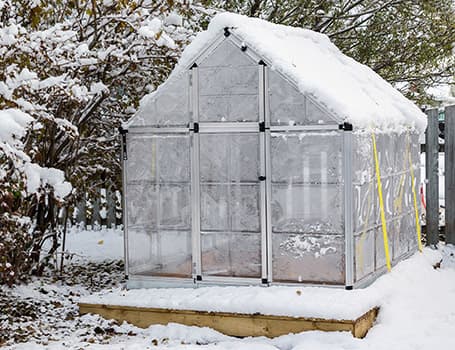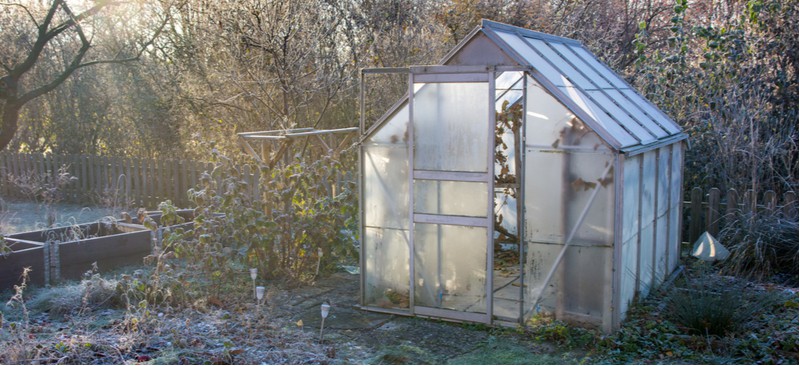You have this year a beautiful flowering oleander or other Mediterranean plant in the garden and want to enjoy it next summer? Then you need a well-tempered winter quarters and must insulate your greenhouse for this. Now you can find out how and with what you can best do this!
Contents
- 1 The Right Insulation Material
- 2 5-Step Guide to Greenhouse Insulation
- 3 Insulate greenhouses and protect non-hardy plants
- 4 Frequently asked questions
- 5 How do I attach styrofoam panels for greenhouse insulation?
- 6 How does the heat stay in the greenhouse?
- 7 How much film do I need for greenhouse insulation?
- 8 Why and when do I need to insulate my greenhouse?
- 9 Author
The Right Insulation Material
If you insulate your greenhouse, you can save on heating costs and ensure that the internal temperature does not drop too low and the plants are not damaged, even in unheated greenhouses.
Suitable insulation material must be translucent so that the winter sun can shine in and warm up the inside of the greenhouse. This eliminates materials that have proven themselves in construction, such as cork, rock wool, wood wool and glass wool for greenhouse insulation. We also recommend anti-dust materials that repel dust and dirt, keeping them as clean as possible for maximum light transmission. Now get to know the most popular insulation materials for greenhouses:

Light Permeable Bubble Wrap
Insulation with bubble wrap – or bubble wrap – is the most common method of winterizing a greenhouse. You probably already know the material as a cushioning packing material. However, due to the air cushions, the film also has an excellent insulating effect, which is why it is also suitable for greenhouse insulation.
Bubble wrap is UV-stable and has a three-layer structure. There are air-filled nubs between two film sheets. With these, the larger the nubs, the better the thermal insulation.
The bubble foil is available by the meter in various widths. We recommend using the widest possible bubble wrap of two meters. Then you will have to attach fewer sheets to the greenhouse. In addition, this way there are fewer gaps between the individual sheets, which cause unwanted thermal bridges and allow warm air to escape.
Lattice film
Lattice film is well suited for outdoor use due to its extreme robustness. The multilayer material is characterized by high tear strength, weather and UV resistance. In addition, the film is resistant to temperature extremes from -40 to +80° Celsius.
An incorporated monofilament thread creates the distinctive grid structure and gives the film great stability. Thus, lattice film defies wind and weather even in winter.
However, its heat-insulating properties are significantly lower than those of bubble wrap. Only with a sufficient thickness of about 250g/m2 the material fulfills insulation function.
Perforated tarpaulins
As an alternative to bubble wrap and mesh film, you can also use perforated cover tarps for greenhouse insulation. These are plastic tarps that are perforated for increased light transmission.
Cover tarps have a long lifespan and will most likely last through many winters. However, thermal insulation is also less than bubble wrap.
In addition, cover tarps usually have an obscuring effect. To compensate for the lost daylight, so-called assimilation lighting is often installed when using tarpaulins. This is targeted, artificial plant lighting.
Hollow chamber multiwall sheets
Thermal insulation with hollow-core multiwall sheets works in a similar way as with bubble wrap. Here, too, air chambers between two polycarbonate sheets provide the insulation effect. Unlike the film, the hollow-core multiwall sheets are rigid, more complicated to install and more intended for permanent use. In many greenhouses, the walls are also already made of transparent hollow-chamber multiwall sheets to integrate the insulation effect from the very beginning.
Styrofoam sheets
While the various films and hollow-core web panels are mostly transparent and therefore well-suited for insulating greenhouse glazing, you can use Styrofoam panels to clad the base of the greenhouse. Styrofoam is a particularly effective insulating material with a low heat transfer coefficient or k-value. This means that heat does not penetrate very well through Styrofoam to the outside, and the heat is stored particularly well in the greenhouse.
Mounting systems
To attach the various films to the greenhouse glazing, you can use different mounting systems. Some insulating films are provided with a nail edge, in which already prefabricated holes are embedded. You can use these to attach the film to hooks.
In addition, there are special greenhouse film holders. These are metal pins that you fix directly to the pane using suction cups or adhesive. The pins can then be pushed through the film and screwed with a plastic nut.
The advantage of greenhouse film holders: the metal pins for fastening, when you remove the film in the summer, you can simply leave them glued. The next winter, you can reattach the film with a perfect fit.
Alternatively, the insulating films can also be simply attached with double-sided adhesive tape. In this case, however, make sure that the adhesive tape is UV and weather resistant and retains its adhesive strength even in the presence of moisture.
Tip:
Also use tape to join adjacent sheets of film together and reduce potential thermal bridging.
Seasonal greenhouse insulation
It is usually sufficient to add insulation to your greenhouse from October to March. However, since night frosts can still occasionally occur in late spring, we recommend leaving the insulation on the greenhouse a little longer, depending on the weather conditions that year.
In the summer, store the film in a dry place, protected from light, so as not to expose it to increased UV radiation during the warmer months.
By the way: If you have chosen greenhouse film holders, you can attach so-called shade nets to them in summer. This way you protect your plants from overheating when there is a lot of sunlight.
5-Step Guide to Greenhouse Insulation

You have decided to use an insulating film? Then the only question now is where and how best to attach it.
We recommend attaching bubble wrap, grid wrap, and tarps to the outside of the greenhouse. This may be a visual disadvantage and the film is more exposed to the weather there, but condensation can form on the inside between the film and the greenhouse wall.
Condensation can lead to algae growth on the glass and increase the amount of cleaning required. In addition, the high humidity is bad for the climate in the greenhouse and can harm your plants. In the worst case, the water freezes in sub-zero temperatures and causes damage to the panes.
And how to proceed with greenhouse insulation? Just follow our step-by-step guide for that:
Eliminate leaks:
First, close open joints, gaps and cracks between profiles, on windows and doors, and at the transition to the foundation. Silicone is suitable for this.
Clean windows:
Dirty greenhouse panes reduce the light yield. Therefore, you should clean the greenhouse again before applying the light-reducing insulating film. In addition, the surface should be free of grease so that the film holders adhere optimally.
Attach film holders:
Attach the film holders to the greenhouse panes using adhesive or suction cups. Depending on the heaviness of the film, you may need more or fewer holders. However, it is usually sufficient if you attach the foil holders at a distance of about 50 cm
Attach insulating film:
First attach the insulating film to the upper edge of the greenhouse wall and fix it there with the plastic nut. Then unroll the foil web downwards and fix it to the foil holders there as well.
Cut the foil web at the bottom of the greenhouse wall with scissors or a cutter knife. Now you can attach the next sheet. Allow the film sheets to overlap a bit to avoid gaps and thermal bridges. Repeat the process until you have covered all the walls of your greenhouse.
Insulate greenhouses and protect non-hardy plants
With the right greenhouse insulation, you can also winter Mediterranean potted plants like oleander and olive trees well in the greenhouse. If your plants need even warmer temperatures, we advise you to additionally install a greenhouse heater. The greenhouse insulation will then reduce the heating requirements compared to non-insulated greenhouses.
We wish you continued enjoyment of your plants after the next winter!
Frequently asked questions
Here you will find answers to questions we are frequently asked.
How do I attach styrofoam panels for greenhouse insulation?
Attach the Styrofoam panels to a clean and dry surface using a suitable adhesive.
When doing so, make sure that the boards are firmly butted together and that butt and bed joints remain free of adhesive. A second row of Styrofoam boards on top is best applied with offsets.
How does the heat stay in the greenhouse?
If you want to reliably retain heat in your greenhouse, you need effective insulation.
In addition, you should regularly check your greenhouse for leaks through which heat can escape. You should seal these with silicone.
How much film do I need for greenhouse insulation?
How much film you need to insulate your greenhouse with depends on the size of your greenhouse. You will have a minimum material requirement equal to the greenhouse surface area.
In addition, there is a certain amount of waste and overlapping of the film sheets to avoid thermal bridges.
Why and when do I need to insulate my greenhouse?
Greenhouse insulation prevents greenhouse temperatures from dropping too low during cold months and damaging your plants.
As a result, insulation also reduces heating needs and the associated heating costs.

